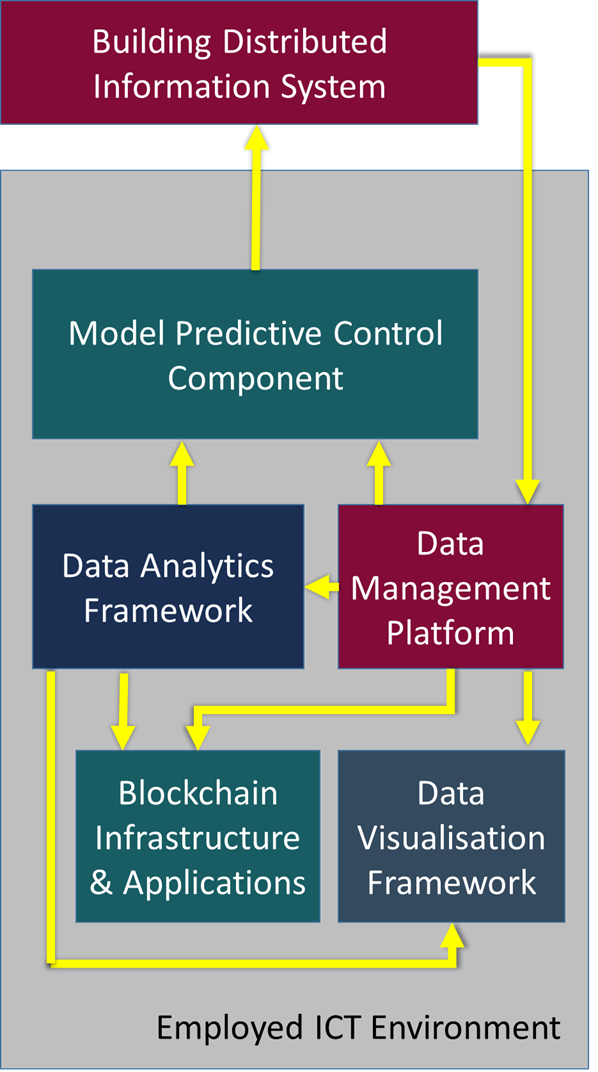New technological and ICT integration specifications lay the groundwork for real-life positive energy buildings
20 January 2022
Update from EXCESS’ technical implementation, January 2022
Significant progress has been made in defining specifications of the EXCESS information and communications technology (ICT) architecture that will drive the design and development of positive energy building technology components across the four demo cases of the project. These technological advances in user integration via ICT lay the groundwork for the demo site concepts to become real-life positive energy buildings.
Konstantinos Latanis, Project Manager at Suite5 Data Intelligence Solutions, and EXCESS lead on the the work related to ICT technical developments:
“The EXCESS project is not just developing positive energy buildings. It's also conducting important research to help others follow in its footsteps. These new specifications and developments help us move buildings a step closer to becoming energy positive. The innovative work will be validated in demo sites across Europe and we are happy to share our achievements with anyone looking for inspiration,” says Latanis.
Interoperable Data Management Framework
EXCESS technical partner Suite5 recently finalised the development and deployment of the first release of the EXCESS Data Management Platform (DMP). Moreover, the team issued a first release of the EXCESS Common Information Model. Components of the EXCESS DMP include functions for data collection, mapping, cleaning, anonymisation, storage as well as user management.The EXCESS Common Information Model was implemented in order to facilitate the interoperability of datasets in the EXCESS DMP. The model was informed by studying the most important standards in the energy and building domain and by the data samples sent by the demonstrator partners. These advancements are documented in the recently published Deliverable 3.2 “EXCESS Data Management Framework”. This report describes the design and development of the EXCESS DMP and the EXCESS Common Information Model in more detail.
Core ICT platform services
Development of the three different services are ongoing, and once these forecasting and profiling components of the EXCESS Data Analytics Framework are completed, they will facilitate the analysis of data residing in the EXCESS DMP.
The three components are:
- Comfort profiling component
The Comfort Profiling Component will enable the definition of the comfort profiles of the building occupants in the different demo site buildings of the EXCESS project. It will digest data coming from the sensors and actuators of the buildings and, through profiling mechanisms, it will specify the comfort boundaries of building occupants. - Generation forecasting component
The Generation Forecasting Component will facilitate the definition of short and mid-term forecasts regarding the operation of the energy generation components of the demo sites, combining also data from the local weather stations. - Demand forecasting component
Similarly, the Demand Forecasting Component will allow the elaboration of short and mid-term forecasts for the demand of the devices and loads of the demo sites buildings, combining also data from the local weather stations.
Flexibility analysis and forecasting component
An important aspect for positive energy buildings is flexibility. Buildings must accommodate constant changes in weather, energy production as well as the needs of residents and users.
In EXCESS, the design of the Context-Aware Flexibility Profiling and Analytics Component as well as the VPP (Virtual Power Plant) Dynamic Configuration Component is advancing well. Once up and running, these elements will complete the EXCESS Data Analytics Framework suite, by enabling the optimised control of devices and loads in the demo site buildings along with the facilitation of flexibility trading in the local energy markets. The components are therefore key to making the EXCESS demo case buildings energy positive. Moreover, dedicated Data Visualization Components for aggregators and building managers will be developed to facilitate their activities towards the achievement of the PEB concept.
Building / district monitoring and control component
Work on the baseline Model Predictive Control (MPC) component is progressing and is being informed by the outcomes of the baseline design. EXCESS partner VTT has begun adapting the MPC component for each demo site, and the first release is expected in the near future. As is the case with the other components, the MPC functionality plays an important role in enabling the energy optimization of demo site buildings to attain PEB status, by employing control functions for the energy-efficient operation of devices and loads in the buildings.
Blockchain-enabled applications for local energy communities and flexibility trading
The development of the first release of the EXCESS blockchain infrastructure has further progressed and the design of the Objective Benefit Sharing Application as well as the Explicit Demand Response Application has started. The delivery of the first release of the EXCESS blockchain infrastructure and its related applications is expected by February 2022.
Sign up to the EXCESS newsletter to stay in the loop!

All news
